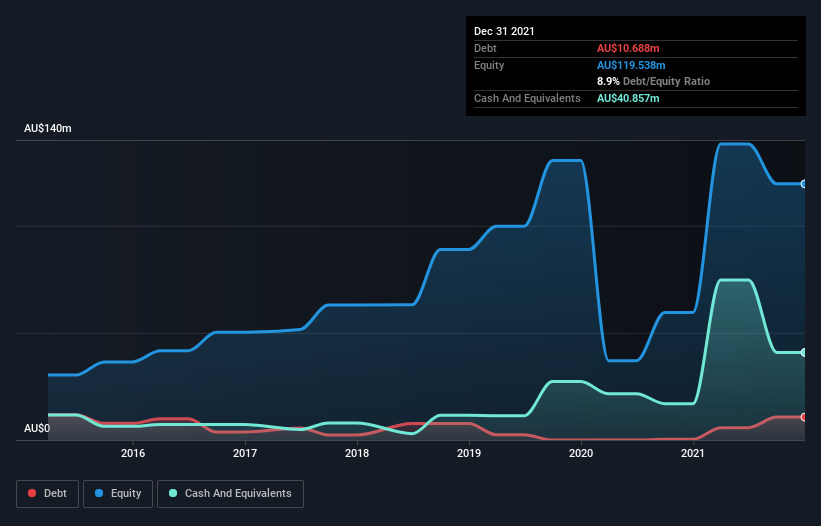Some say volatility, rather than debt, is the best way to think about risk as an investor, but Warren Buffett famously said that 'Volatility is far from synonymous with risk.' So it seems the smart money knows that debt - which is usually involved in bankruptcies - is a very important factor, when you assess how risky a company is. Importantly, Strike Energy Limited (ASX:STX) does carry debt. But the real question is whether this debt is making the company risky.
When Is Debt A Problem?
Debt and other liabilities become risky for a business when it cannot easily fulfill those obligations, either with free cash flow or by raising capital at an attractive price. If things get really bad, the lenders can take control of the business. However, a more frequent (but still costly) occurrence is where a company must issue shares at bargain-basement prices, permanently diluting shareholders, just to shore up its balance sheet. Of course, the upside of debt is that it often represents cheap capital, especially when it replaces dilution in a company with the ability to reinvest at high rates of return. When we think about a company's use of debt, we first look at cash and debt together.
Check out our latest analysis for Strike Energy
What Is Strike Energy's Debt?
You can click the graphic below for the historical numbers, but it shows that as of December 2021 Strike Energy had AU$10.7m of debt, an increase on AU$322.0k, over one year. But on the other hand it also has AU$40.9m in cash, leading to a AU$30.2m net cash position.

A Look At Strike Energy's Liabilities
The latest balance sheet data shows that Strike Energy had liabilities of AU$18.4m due within a year, and liabilities of AU$17.7m falling due after that. Offsetting these obligations, it had cash of AU$40.9m as well as receivables valued at AU$1.66m due within 12 months. So it can boast AU$6.37m more liquid assets than total liabilities.
Having regard to Strike Energy's size, it seems that its liquid assets are well balanced with its total liabilities. So while it's hard to imagine that the AU$607.5m company is struggling for cash, we still think it's worth monitoring its balance sheet. Simply put, the fact that Strike Energy has more cash than debt is arguably a good indication that it can manage its debt safely. There's no doubt that we learn most about debt from the balance sheet. But it is future earnings, more than anything, that will determine Strike Energy's ability to maintain a healthy balance sheet going forward. So if you want to see what the professionals think, you might find this free report on analyst profit forecasts to be interesting.
Given its lack of meaningful operating revenue, Strike Energy shareholders no doubt hope it can fund itself until it can sell some combustibles.
So How Risky Is Strike Energy?
By their very nature companies that are losing money are more risky than those with a long history of profitability. And we do note that Strike Energy had an earnings before interest and tax (EBIT) loss, over the last year. Indeed, in that time it burnt through AU$41m of cash and made a loss of AU$16m. But at least it has AU$30.2m on the balance sheet to spend on growth, near-term. Overall, its balance sheet doesn't seem overly risky, at the moment, but we're always cautious until we see the positive free cash flow. The balance sheet is clearly the area to focus on when you are analysing debt. However, not all investment risk resides within the balance sheet - far from it. For example, we've discovered 5 warning signs for Strike Energy (3 are a bit concerning!) that you should be aware of before investing here.
Of course, if you're the type of investor who prefers buying stocks without the burden of debt, then don't hesitate to discover our exclusive list of net cash growth stocks, today.
New: Manage All Your Stock Portfolios in One Place
We've created the ultimate portfolio companion for stock investors, and it's free.
• Connect an unlimited number of Portfolios and see your total in one currency
• Be alerted to new Warning Signs or Risks via email or mobile
• Track the Fair Value of your stocks
Have feedback on this article? Concerned about the content? Get in touch with us directly. Alternatively, email editorial-team (at) simplywallst.com.
This article by Simply Wall St is general in nature. We provide commentary based on historical data and analyst forecasts only using an unbiased methodology and our articles are not intended to be financial advice. It does not constitute a recommendation to buy or sell any stock, and does not take account of your objectives, or your financial situation. We aim to bring you long-term focused analysis driven by fundamental data. Note that our analysis may not factor in the latest price-sensitive company announcements or qualitative material. Simply Wall St has no position in any stocks mentioned.
About ASX:STX
Strike Energy
An independent gas producer, explores for and develops oil and gas resources in Australia.
Good value with reasonable growth potential.
Similar Companies
Market Insights
Community Narratives





